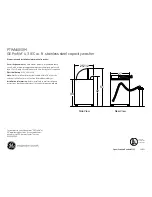
EN
11
Rinse aid and refined salt
Only use products which have been specifically designed
for dishwashers.
Do not use table/industrial salt or washing-up liquid.
Follow the instructions given on the packaging.
If using a multi-functional product it is not necessary to add
any rinse aid. However,
we recommend that you add salt,
especially if you live in an area where the water is hard or
very hard.
(Follow the instructions given on the packaging).
If you do not add salt or rinse aid, the LOW SALT
*
and
LOW RINSE AID indicator lights will stay lit.
Measuring out the rinse aid
Rinse aid makes it easier for the crockery to dry, as water runs off
the surfaces more readily and therefore does not leave streaks
or marks. The rinse aid dispenser should be filled:
• When the LOW RINSE AID indicator light
*
on the control panel
is illuminated, a reserve supply of rinse aid is still available
for 1-2 cycles;
1. Open the dispenser
“D”
by pressing and pulling up the tab
on the lid;
2. Carefully introduce the rinse aid as far as the maximum
reference notch of the filling space - avoid spilling it. If this
happens, clean the spill immediately with a dry cloth.
3. Press the lid down until you hear a click to close it.
NEVER pour the rinse aid directly into the appliance tub.
Adjusting the amount of rinse aid
If you are not completely satisfied with the drying results, you
can adjust the quantity of rinse aid. Switch on the dishwasher
using the ON/OFF button, wait a few seconds and switch it off
using the ON/OFF button. Press the Start/Pause button 3 times;
switch on the machine using the ON/OFF button and access
the adjustment menu - the rinse-aid indicator light is lit
(set to
factory level).
Adjust the level of rinse aid supply using the WASH CYCLE
SELECT knob. There is a rinse aid level for each wash cycle
(0 to 4 max).
Press the ON/OFF button to save the setting.
If the rinse aid level is set to ZERO (ECO), no rinse aid will be
supplied. The LOW RINSE AID indicator light will not be lit if you
run out of rinse aid.
• If there are streaks on the crockery, set a low number (1-2).
• If there are drops of water or limescale marks, set a high
number (3-4).
Setting the water hardness
Every dishwasher is equipped with a water softener which, by
using refined salt designed specially for this type of appliance,
supplies water without limescale which is then used to wash
the crockery.
This dishwasher has a setting that helps reduce pollution and
optimises washing performance in accordance with the water
hardness level in your area. Ask your local water supplier for
this information.
- Switch on the dishwasher using the ON/OFF button, wait a
few seconds and switch it off using the ON/OFF button. Hold
down the Start/Pause button for min. 3 seconds; switch on the
machine using the ON/OFF button and access the adjustment
menu - the salt indicator light is lit.
-Select the desired level using the SELECT WASH CYCLE knob
(1 to 5
*
Max.)
(water softener set to medium level).
Press the ON/OFF button to save the setting.
Even if using multi-functional tablets, fill the salt dispenser.
(°dH = hardness measured in German degrees - °f = hardness
measured in French degrees – mmol/l = millimoles per litre)
Measuring out the refined salt
In order to obtain the best possible results from a wash cycle,
make sure that the salt dispenser is never empty.
Refined salt removes limescale from the water, thus avoiding
the formation of deposits on crockery.
The salt dispenser is located in the lower part of the dishwasher
(see Description)
and should be filled:
• When the green float
*
cannot be seen by simply looking at
the cap of the salt dispenser;
•
When the LOW RINSE AID indicator
light on the control panel is illuminated
*
;
1. Remove the lower rack and unscrew
the cap (anticlockwise).
2. The first time you do this: fill the water
tank right up to its edge.
3. Position the funnel
*
(see figure)
and
fill the salt dispenser up to the edge
(approximately 1 kg). It is normal for a little water to leak out.
4. Remove the funnel* and wipe any salt residues away from
the opening; rinse the cap under running water and then screw
it on, the head facing downwards so as to let the water flow out
of the four slots (star-shaped arrangement) in the lower part of
the cap (cap with green float
*
).
It is advisable to perform this procedure every time you add
salt to the dispenser.
Make sure the cap is screwed on tightly so that no detergent can
get into the container during the wash cycle (this could damage
the water softener beyond repair).
When necessary, measure out the salt before a wash cycle
so that any saline solution which has leaked out of the salt
dispenser is removed.
*
Only available in selected models.
M
A
X
Water Hardness Table
Average salt dispenser
capacity duration
**
level
°dH
°fH
mmol/l
months
1
0 - 6
0 - 10
0 - 1
7 months
2 6 - 11
11 - 20
1,1 - 2
5 months
3 12 - 17 21 - 30
2,1 - 3
3 months
4 17 - 34 31 - 60
3,1 - 6
2 months
5
*
34 - 50 61 - 90
6,1 - 9
2/3 weeks
For values between 0°f and 10°f, we do not recommend the use of salt.
*
a setting of 5 may increase cycle duration.
**
1 wash cycle per day.
Summary of Contents for DFG 15M10
Page 27: ...TR 27 ...
Page 28: ...TR 28 195116085 01 08 2013 jk Xerox Fabriano ...












































